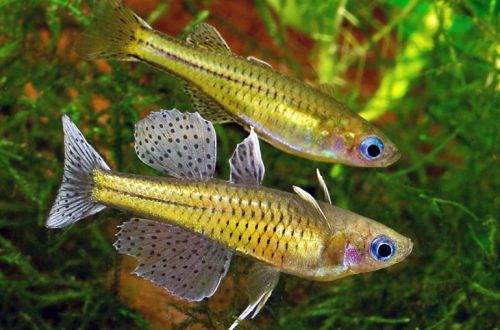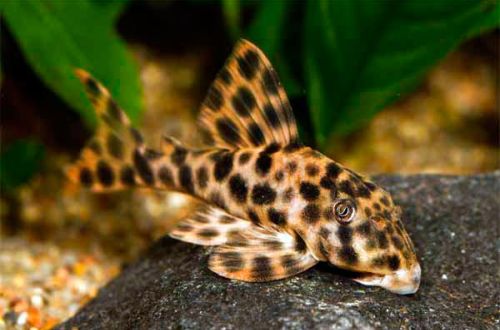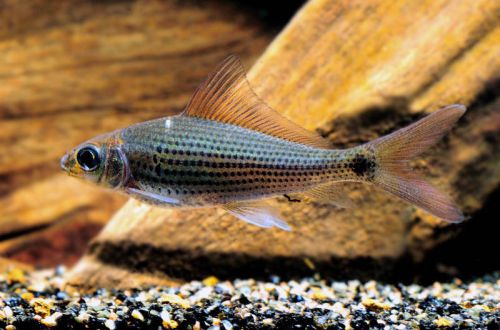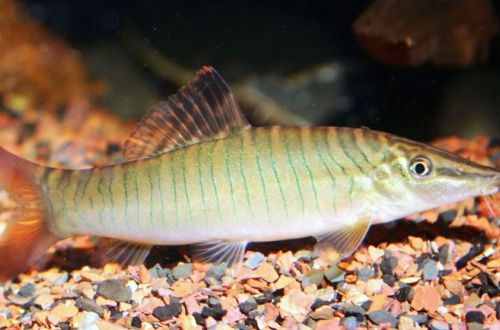
spotted blue-eye
Pseudomugil Gertrude or Spotted blue-eye, scientific name Pseudomugil gertrudae, belongs to the Pseudomugilidae family. The fish is named after the wife of the German naturalist Dr. Hugo Merton, who discovered this species in 1907 while exploring eastern Indonesia. Unpretentious and easy to maintain, due to its size it can be used in nano aquariums.

Contents
Habitat
Occurs from the northern part of Australia and the southern tip of New Guinea, also found in the numerous islands between them, located in the Arafura and Timor Seas. They live in small shallow rivers with a slow current, swamps and lakes. They prefer regions with dense aquatic vegetation and numerous snags. Due to the abundance of organic matter, the water is usually colored brownish.
Brief information:
- The volume of the aquarium – from 40 liters.
- Temperature – 21-28°C
- Value pH — 4.5–7.5
- Water hardness – soft (5-12 dGH)
- Substrate type – any
- Lighting – subdued / moderate
- Brackish water – no
- Water movement – little or no
- The size of the fish is up to 4 cm.
- Food – any floating food, mostly meat
- Temperament – peaceful
- Keeping in a flock of at least 8-10 individuals
Description
Adult fish reach a length of about 4 cm. The color is yellow with white translucent fins dotted with black specks. A distinctive feature are blue eyes. A similar feature is reflected in the name of this fish. Sexual dimorphism is weakly expressed. Males are slightly larger and brighter than females.
Food
They accept all types of food of a suitable size – dry, frozen, live. The latter are the most preferred, for example, daphnia, brine shrimp, small bloodworms.
Maintenance and care, decoration of the aquarium
Aquarium sizes for a flock of 8-10 fish start at 40 liters. The design uses dense thickets of plants arranged in groups to preserve free areas for swimming. Additional shelters in the form of snags are welcome. Any soil is selected based on the needs of plants.
The fish does not respond well to bright lighting and excessive water movement, so equipment should be selected based on these features.
Water conditions have slightly acidic pH values with low hardness. To maintain high water quality, it is necessary to update it weekly by 15–20% of the volume, and also install a productive filtration system.
Behavior and Compatibility
Calm peaceful fish. Compatible with species of similar size and temperament. Content in a flock of at least 8-10 individuals of both sexes. Best results are achieved in a species tank where small freshwater shrimp are used as neighbors.
Breeding / breeding
Breeding the Spotted blue-eye is quite simple and does not require separate preparations. Spawning can occur at any time during the year. The impetus for the beginning of the mating season is an increase in temperature to the upper allowable values (26–28 ° C).
The females lay their eggs among the thickets of plants. For these purposes, small-leaved and undersized species, such as Java moss, or artificial spawning plants (including home-made ones), are best suited. The dominant male usually fertilizes several clutches from different females at once. Parental instincts are not developed; immediately after spawning, fish can eat their own eggs.
In order to preserve future offspring, fertilized eggs are timely transferred to a separate tank with identical water conditions. The fry will stay in it until they grow large enough (usually about six months). This separate tank is equipped with the same set of equipment as the main aquarium. The exception is the filtration system, in this case it is worth using a simple airlift filter with a sponge as a filter material. It will provide sufficient cleaning and avoid accidental suction of fry.
The incubation period lasts about 10 days, depending on the temperature. In the first days of life, micro-feed, such as ciliates, will be required. A week later, you can already serve Artemia nauplii.
Fish diseases
Health problems arise only in case of injuries or when kept in unsuitable conditions, which depresses the immune system and, as a result, provokes the occurrence of any disease. In the event of the appearance of the first symptoms, first of all, it is necessary to check the water for the excess of certain indicators or the presence of dangerous concentrations of toxic substances (nitrites, nitrates, ammonium, etc.). If deviations are found, bring all values back to normal and only then proceed with treatment. Read more about symptoms and treatments in the Aquarium Fish Diseases section.





